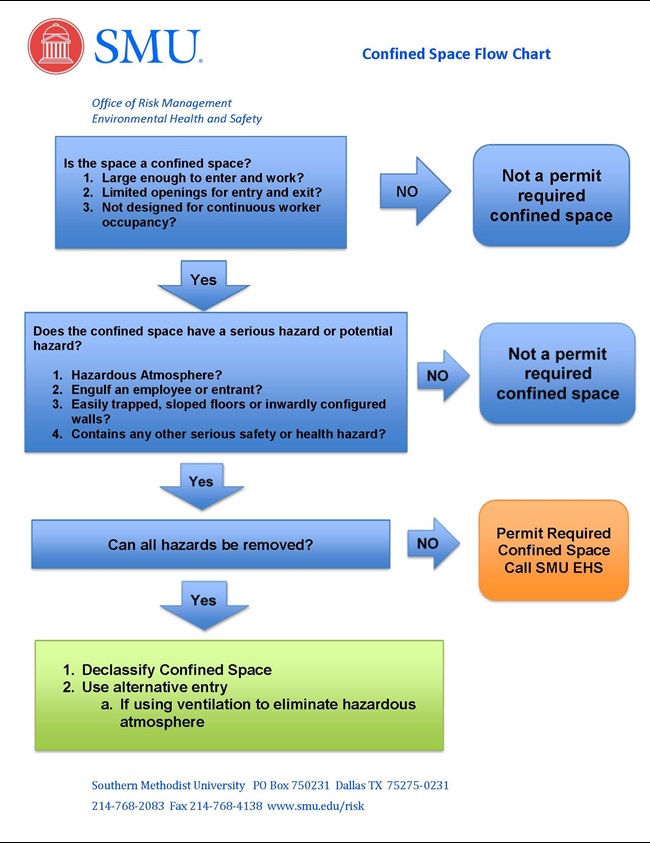Confined Spaces
SMU EHS manages the confined space program on the SMU campus. SMU has hundreds of confined spaces on campus, and the program is to ensure the safety of students, faculty, staff, guest, and contractors. Any person entering a confined space on campus is required to follow the SMU Confined Space Program. For full details of confined spaces, hazards, hazard mitigation and SMU policies please review the 2019 EHS PRCS Program.
Permits
At SMU, we use work permits to help ensure safety. Confined Space Permits are required to enter a confined space by SMU policy and OSHA Federal Law. Below is the type of confined space permits issued on campus.
- Permit-Required Confined Spaces
- PRCS Permits is used when someone is entering a confined space with a known hazard.
- PRCS Permits require all aspects of the SMU Confined Space Program.
- PRCS require specialized training, minimum equipment, confined space rescue team.
- Requires SMU EHS authorization before entering.
- Declassified Confined Space
- Declassified confined spaces are confined space with no known hazards.
- Employees may enter confined spaces after checking for potential hazards and eliminating those hazards
- Require a declassified permit.
- Declassified permits can be filled out online.
- Online Declassified Confined Space Permit
Contractors
Contractors must inform subcontractors of hazards and SMU policies. Contractors will provide their own PRCS required equipment. Contractors without the minimum gear required will not receive a signed permit.
Contractor minimum PRCS gear list:
- 4 gas meter
- Full Body Harness
- Ventilation Blower
- Retrieval System lifeline
- A tripod retrieval system if vertically over 5 feet
- Communication Plan
- Adequate Lighting
- Other gear as required:
- FR clothes,
- gloves,
- hardhat,
- Safety Glasses,
- proper shoes/boots
Definitions
Confined Space
- Confined space contains all three following below:
- A confined space is a location that is large enough for an employee to enter and perform assigned work.
- A confined space has limited or restricted means of entry or exit.
- A confined space is a location not designed for continuous employee occupancy.
Common Confined Spaces Examples: tunnels, sewers, tanks, manholes, small industrial spaces, storm drains, crawl spaces, electrical vaults, and basements.
Confined Spaces that do not have any hazards do not need a permit to enter. See Hazard and Hazard Control section for more information.
Permit-Required Confined Space (PRCS)
A permit-required confined space is a confined space with one of the following:
- 1.It contains or has the potential to contain a hazardous atmosphere.
- 2.It contains a material that has the potential to engulf an employee or entrant.
- 3.The confined space is configured in such a way that an employee could become trapped by sloped floors or inwardly configured walls.
- 4.Or contains any other serious safety or health hazard.
Declassified Confined Space
A Declassified Confined Space was a Permit-Required Confined space where all known and potential hazards are removed.
Once declassified, employees can work in the confined space without the full permit-required confined space requirements.
A declassified confined space may remain declassified until the project is completed or a hazard is identified.
Rescue Team
Rescue Teams are highly trained people who are authorized by EHS or governmental organizations having jurisdiction to enter a permit-required confined space to rescue injured entrants.
- Rescue Teams are required for all permit-required confined spaces.
- A rescue team must be notified before any permit-required confined space entry, or a confined space permit is released from SMU EHS.
- Calling 911 is not a substitute for having a standby rescue team.
Inventory
The majority of the confined spaces on campus do not have any known hazards. SMU Office of Risk Management (ORM) maintains an inventory of recognized Permit-Required Confined Spaces. Known Confined Spaces will be assessed and documented for potential hazards. Employees and Rescue teams should not rely on the information in the confined space inventory alone.
